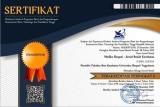GAMBARAN BALITA STUNTING BERDASARKAN KARAKTERISTIK DEMOGRAFI IBU DI WILAYAH KERJA PUSKESMAS PUNDONG BANTUL YOGYAKARTA
Abstract
Background: Stunting is still a children’s nutrition problem at this time. The percentage of cases of stunting children’s is increasing. Stunting can affect children in the long run, that is, disrupt health, education and productivity in the future. Maternal demographic factors are thought to be a factor that plays a role in the occurrence of stunting children.Purpose: provide an overview and discussion of stunting based on maternal demographic characteristics.Method: This research is a non-experimental research with an observational descriptive approach. Data was collected using a demographic characteristics questionnaire. The sample in this study was 90 stunting toddlers in the working area of the Pundong Community Health Center, Bantul, Yogyakarta. The sampling technique in this study uses simple random sampling. Data analysis uses percentage formulasResults: in stunting toddlers, the majority of maternal’s aged less than 30 years were 52 people (58%), the majority of maternal’s' education was low education (junior high school and elemtary school) which was 60 people (66%), the number of family members was more than 4 people were as many as 64 respondents (66.7%), the majority of mother who did not work were 52 people (57.8%), had incomes that were less than district minimum wage, which were 63 people (70%).Conclusion: there are several parental demographic factors that have a role in the occurrence of stunting under five, such as: maternal’s age, level of education, number of family members, employment status, and family income.
Keywords
Full Text:
PDFReferences
Amin, NA., & Julia, M. 2014. Faktor Sosiodemografi dan Tinggi Badan Orangtua serta Hubunganya dengan Kejadian Stunting pada Balita Usia 6-23 bulan. Jurnal Gizi dan Dietetik Indonesia, Vol. 2 No.3, Hal. 170-177.
Aryanti, PH., Oktavianto, E., & Suryati 2019. Hubungan Keterlibatan Ayah dalam Pengasuhan dengan Kelekatan Anak Usia Prasekolah. Jurnal Kesehatan Al-Irsyad , Vol. XII, No.2, Hal. 83-94.
Chaudury, R. 2012. Determinants of Dietary Intake and Dietary Adequacy for Preschool Children in Bangladesh. Bangladesh Institute of Development Studies. Available from: http://archive.unu.edu/.
Handayani, S., Kapota, WN., & Oktavianto, E. 2019. Hubungan Status ASI Ekslusif dengan Kejadian Stunting pada Balita Usia 24-36 bulan di Desa Watugadjah Kabupaten Gunungkidul. Jurnal Medika Respati, Vol.14, No.4, Hal. 287-300.
Hapsari, W. 2018. Hubungan Pendapatan Keluarga, Pengetahuan Ibu tentang Gizi, Tinggi Badan Orangtua, dan Tingkat Pendidikan Ayah dengan Kejadian Stunting pada Anak Umur 12-59 Bulan (Tesis). Surakarta: Universitas Muhammadiyah Surakarta. Diunduh dari http://eprints.ums.ac.id/58665/1/NASKAH%20PUBLIKASI%20WINDI.pdf.
Kulwa, K., Verstraeten, R., Bouckaert, K., Mamiro, P., Kolsteren, P., & Lachat, C. 2014. Effectiveness of a nutrition education package in improving feeding practices, dietary adequacy and growth of infants and young children in rural Tanzania: rationale, design and methods of a cluster randomised trial. BMC Public Health 2014, 14:1077.
Ni’mah, K., & Nadhiroh, S.R. 2015. Faktor yang Berhubungan dengan Kejadian Stunting pada Balita. Media Gizi Indonesia, Vol. 10, No.1 Hal.13-19.
Notoatmodjo, S. 2012. Promosi Kesehatan: teori dan aplikasinya. Jakarta: PT. Rineka Cipta.
Oktavianto, E., Karimah, Timiyatun, E., & Badi’ah, A. 2018. Pelatihan Bermain pada Ibu Meningkatkan Kelekatan Anak. MEDISAINS: Jurnal Ilmiah Ilmu-Ilmu Kesehatan, Vol.16, No.3; Hal.120-126.
Shi, L., Zhang, J., Wang, Y., Caulfield, L. E., & Guyer, B. 2010. Effectiveness of an educational intervention on complementary feeding practices and growth in rural China: a cluster randomised controlled trial. Public Health Nutrition Journal, Vol.13, No.4, Hal. 556-65. Diunduh dari https://www.ncbi.nlm.nih.gov/pubmed/19706219.
Suciningtyas, DS., Triharini, M., & Rachmawati, PB. 2019. Hubungan Data Demografi Keluarga dalam Pemberian ASI Eksklusif Anak Balita Stunting. Pediomaternal Nursing Journal, Vol.5, No.1, Hal. 132-136.
Susanty, M. 2011. Hubungan Perilaku tentang Pencegahan Malnutrisi dengan Kejadian Gizi Buruk di Desa Bukit Padi Kecamatan Jemaja Kabupaten Natuna (Skripsi). PSIKM FK Unand: Padang.
Sulastri, D. 2012. Faktor Determinan Kejadian Stunting pada Anak Usia Sekolah di Kecamatan Lubuk Kilangan Kota Padang. Majalah Kedokteran Andalas, Vol.36, No. 1, Hal.39-50. Diunduh dari http://jurnalmka.fk.unand.ac.id/index.php/art/article/view/111.
Welassih, BD., & Wirjatmadi, RB. 2012. Beberapa Faktor yang Berhubungan dengan Status Gizi Balita Stunting. The Indonesian Journal of Public Health, Vol.8, No.3, Hal.8-20.
DOI: https://doi.org/10.35842/mr.v15i1.256
Article Metrics
Abstract view : 809 ViewPDF - 152 View
Refbacks
- There are currently no refbacks.
Copyright (c) 2020 Suryati suryati, Supriyadi Supriyadi, Eka Oktavianto
Medika Respati : Jurnal Ilmiah Kesehatan indexed by:








